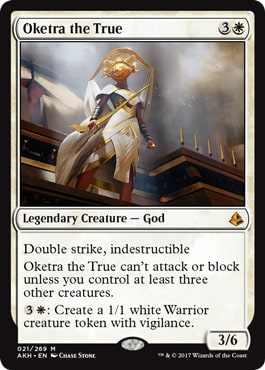Following the brighter environment of Kaladesh came Amonkhet - a set based on ancient Egypt and the mythology of that ancient culture. This world set us up for the upcoming and ongoing conflict with Nicol Bolas that would soon come to a head in the following Hour of Devastation. However here we got to see a more intimate look with the plane, its denizens, and its gods - many of whom boast the lauded mythic rarity. We're going to be taking a look through and ranking them all today, so let's get right to it!
Number Fifteen
Glorious End sought to put a new spin on classic cards like Final Fortune, Last Chance, and Warrior's Oath. Those cards were all so good because they gave you a proper extra turn to get to do your nonsense before you inevitably lost the game. Glorious End reads like it should do something similar, but it doesn't give you an extra turn in the same way those other cards do. It's more of a last chance safety valve, which is a totally different use that wasn't all that worth it in the end. The card sees no play anywhere and is pretty much worthless.
Number Fourteen
It feels weird having a god being one of the worst mythics of the set, but I feel like it's pretty accurate. The card is both among the lowest rated cards on EDHREC.com and saw next to no play in any competitive format: not exactly a recipe for success. Getting to attack was fairly easy, as many decks like to sacrifice stuff, but it didn't quite working out in this era. Bontu's own sacrifice effect proved rather middling as well, resulting in an uninspired card.
Number Thirteen
I'll reiterate once more that it still feels a bit odd that there are gods ranked so low, yet here we are once again. Kefnet was extremely disliked when it was revealed, as in a typical game of Magic you're going to play more and more cards as the game goes on. This means maintaining a seven-card hand is quite difficult, making it hard to get any real attack value out of Kefnet. The card did still manage to make its way into a handful of control decks of the era, but most of the time players would simply prefer to win with Approach of the Second Sun and call it a day.
Number Twelve
Cruel Reality does a ton, forcing your opponent to make some serious sacrifices every single turn. The catch, though, was the high cost of seven mana to get it on the board. Players would find ways to get around this, particularly in curse-heavy casual builds utilizing Curse of Misfortunes to cheat it onto the battlefield. However, the card was too costly to make work in almost every other space.
Number Eleven
Of the gods in the original Amonkhet, few proved as much of fan favorites as Oketra. The big cat goddess was an instant hit as one of the earliest cards shown to us from the set. Unfortunately, in practice she wasn't that great anywhere. She proved too slow and hard to set up in Constructed and even Limited. Even in Commander she does too little. In spite of this, she's solid card and a beloved character.
Number Ten
Aside from the odd list like Soulflayer or weird Gruul Bard Class builds, Samut, Voice of Dissent never really saw a ton of Constructed play. Where she quickly excelled, though, was in the casual scene. When it comes to Commander, providing a powerful beatstick is always welcome. It's even more welcome when that beater happens to provide all of your creatures with haste as well, which has made her quite a popular card in our favorite 100-card format.
Number Nine
Compared to most planeswalkers up until this point, most players didn't know what to make of this Nissa. Having an X casting cost meant that provided you had enough mana, you could ultimate her the turn you cast her. Alternatively, you could cast her early and still get value, though that value was a meager scry 2 most of the time. Despite the quirkiness that made evaluating her tough, Nissa proved to be a solid card in Standard and continues to be a popular Commander card to this day - particularly in precons and lower powered lists.
Number Eight
These days, cards like Banisher Priest and Oblivion Ring aren't terribly exciting. This made Angel of Sanctions feel somewhat underwhelming at first, since it was basically just a bigger and flashier version at mythic. However, the rarity upshift was well worth it, as being evasive, dodging Lightning Strike, and being able to come back from the graveyard proved a massive swing in all kinds of games, making it a veritable powerhouse of its time.
Number Seven
Players loved cards like Oracle of Mul Daya and Courser of Kruphix that let them play lands off the top of their deck. It's no surprise, therefore, that many players would also love having the ability to cast lots of creatures off the top of their deck! This ability proved to be an instant hit among the casual crowd and paved its way to becoming a staple of creature-heavy Commander decks until the end of time.
Number Six
During preview season, many players quickly realized that you could get up to some serious shenanigans with As Foretold. Simply by playing a game over time, you could accumulate value by gaining access to free spells every turn. Then players realized you could cast the no-cost suspend spells from Time Spiral for free every turn. Oops! This led to players doing all kinds of nonsense with the likes of Ancestral Vision and Restore Balance in Modern, though the deck ended up fizzling out a bit in the long run. Still, As Foretold continues to be a popular build-around for many players to this day, and it all started from the word go.
Number Five
Early on when I started these mythic ranking articles, I rated a certain card called Platinum Angel extremely high in my piece on Magic 2010. Having the ability to not lose the game and prevent opponents from winning is always going to be massively exciting for players of all kinds, and Gideon of the Trials offers this effect to players. Many thought the card wouldn't be that good, as it was too easy to pick Gideon off once you had the emblem, however thanks to the control decks of the era, it proved a powerful piece to getting those decks across the finish line.
Number Four
This iteration of Liliana was rarely ever the best thing you could be doing. Making a zombie a durn and occasionally reanimating a creature always felt a bit underwhelming for the cost. However, she's proved to be quite a steady utilitarian planeswalker across several formats. Not only did she see fairly modest Standard play in various Midrange decks, she remains a mainstay of both Commander and Cube, and has even shown up in a handful of Pioneer lists to boot. Not a bad showing for everyone's favorite Mono-Black planeswalker!
Number Three
For quite some time, Combat Celebrant was treated like a joke and one of the worst mythics of the set. It was too fragile to be truly effective and exerting it made it hard to make use of in a meaningful way. Then a few months later around the time of Rivals of Ixalan, players began to piece together a new God-Pharaoh's Gift combo deck. This would enable you to get multiple copies of Combat Celebrant online - including eternalized 4/4 copies that could survive battle much more easily! Since then the card has gone on to be a big player in Commander and Cube as well, cementing it as a powerful underdog of the set.
Number Two
While three of the five gods in this set came out with a bit of a thud, the last two proved to be true forces to be reckoned with. Rhonas the Indomitable was one of the best creatures of the time for aggressive Green decks, enabling decks like Gruul Monsters and later Steel Leaf Stompy to be as powerful as they were. Rhonas's legacy continues to this day, showing up in Green Pioneer decks as well as being a popular option in Commander.
Number One
Few decks have left a massive impact on me as a player like Hazoret Red did during this era. It was a tremendously fun and skill-intensive version of Mono-Red Aggro. It beat down heavily, yet was rarely ever good enough to blitz opponents the way you might see nowadays. As you might expect from the name, the big lynchpin to make this era-defining deck work was Hazoret herself, providing a massive hasty indestructible creature that dished out ridiculously high amounts of damage. Even now, she still sees some play in spaces like Cube and even Pioneer with the recent Rakdos Aggro lists. Truly an icon of the era.
Paige Smith
Twitter: @TheMaverickGal
Twitch: twitch.tv/themaverickgirl
YouTube: TheMaverickGal





































